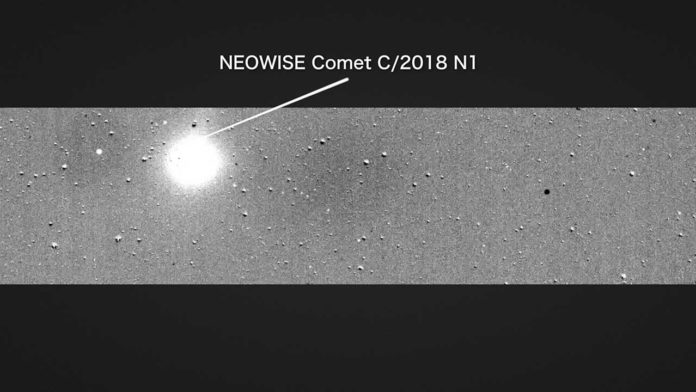Before NASA’s Transiting Exoplanet Survey Satellite (TESS) science activities on July 25, 2018, the planet hunter sent back a dazzling grouping of fortunate pictures demonstrating the movement of a comet.
Assumed control through the span of 17 hours on July 25, these TESS pictures exhibited the satellite’s capacity to gather a drawn-out set of stable intermittent pictures covering a wide region of the sky — every basic factor in finding traveling planets circling nearby stars.
Throughout these tests, TESS took pictures of C/2018 N1, a comet found by NASA’s Near-Earth Object Wide-field Infrared Survey Explorer (NEOWISE) satellite on June 29. The comet, situated around 29 million miles (48 million kilometers) from Earth in the southern constellation Piscis Austrinus, apparently moves over the casing from appropriate to left as it revolves around the Sun.
The comet’s tail, which comprises of gases diverted from the comet by an outpouring from the Sun called the sunlight based breeze, reaches out to the highest point of the edge and steadily rotates as the comet skims over the field of view.
In addition to the comet, the images reveal a treasure trove of other astronomical activity. The stars appear to shift between white and black as a result of image processing. The shift also highlights variable stars — which change brightness either as a result of pulsation, rapid rotation or by eclipsing binary neighbors.
Asteroids in our solar system appear as small white dots moving across the field of view. Towards the end of the video, one can see a faint broad arc of light moving across the middle section of the frame from left to right. This is a stray light from Mars, which is located outside the frame. The images were taken when Mars was at its brightest near opposition, or its closest distance, to Earth.
These images were taken during a short period near the end of the mission’s commissioning phase, prior to the start of science operations. The movie presents just a small fraction of TESS’s active field of view. The team continues to fine-tune the spacecraft’s performance as it searches for distant worlds.
TESS is a NASA Astrophysics Explorer mission led and operated by MIT in Cambridge, Massachusetts, and managed by NASA’s Goddard Space Flight Center in Greenbelt, Maryland. Dr. George Ricker of MIT’s Kavli Institute for Astrophysics and Space Research serves as principal investigator for the mission.
Additional partners include Northrop Grumman, based in Falls Church, Virginia; NASA’s Ames Research Center in California’s Silicon Valley; the Harvard-Smithsonian Center for Astrophysics in Cambridge, Massachusetts; MIT’s Lincoln Laboratory in Lexington, Massachusetts; and the Space Telescope Science Institute in Baltimore. More than a dozen universities, research institutes and observatories worldwide are participants in the mission.
